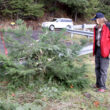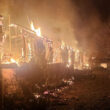Sean C. Morgan
Of The New Era
With a dry spring about to trigger the start of fire season, fire officials say they expect a normal year for fire in the Sweet Home area.
June 1 is the beginning of the annual burn ban, Oregon Department of Forestry Sweet Home Unit Forester Kevin Crowell said. Seasonal staff will be at work for the ODF by mid-June, and the annual interagency fire school will be held in the Sweet Home area the last week of June.
“We’ll be full, staffed and running seven days a week by July 4 weekend,” Crowell said. By July 4, the Sweet Home Unit historically has placed the Quartzville Corridor into regulated use with the rest of the district going into regulated use soon afterward.
Fuels are starting to dry out, Crowell said. “Things are starting to cure on the south slopes.”
The south slopes, visible north of Sweet Home, are starting to brown up, he said. Recent warm temperatures have brought fuel moistures down, and “lawns are going to start curing quickly now.”
The ODF has already responded to some blazes around the state, Crowell said, including five-acre fires in the Tillamook and Molalla areas.
Around Sweet Home, ODF has responded to a number of small fires caused by illegal burns, power lines down and miscellaneous reasons, Crowell said. All have been small, but some of the fires have caused spot fires away from the main fire already this season.
Sweet Home is expected to have a normal fire season, according to the National Wildland Fire Center.
Northeastern and southwestern Oregon are projected to be drier than normal, Crowell said.
Throughout the West, according to the NIFC, drought conditions, along with low snow pack, early snow melt and warmer-than-normal forecast temperatures will likely dry out timber fuels, cause early green-up and bring an early onset for fire season.
Abundant new and carryover “fine” fuels across much of the west are expected to green up and cure early leading to an active and prolonged grassland fire season.
The Northwest experienced a generally wet winter west of the Cascades, according to the NIFC. East of the Cascades, the rain and snowfall were near normal in Washington and below normal in Oregon.
The most significant precipitation deficits were in eastern Oregon and southeastern Washington. Early melt could lead to an earlier start for fire season at lower elevations in eastern Oregon.
As fire season approaches, fire officials warn homeowners near wildlands to prepare.
“More people are building homes in areas bordering on, or in areas vulnerable to wildfire,” said Lee Vaughn, fire prevention coordinator for the Sweet Home unit. “That’s why we encourage you to use fire-resistant materials when designing, building, remodeling or retrofitting your home. The regular maintenance of your property, along with proper landscaping, will go a long way in helping your home survive a wildfire. We encourage each of you to be an active participant in your local community wildland fire risk reduction efforts all year long.”
To increase fire resistance on and around a home, fire officials recommend that residents:
– Cover all vents (roof or foundation) with a fine mesh screen (1/8th inch) to prevent sparks or embers from blowing in or under your home.
– Roof with fire-resistant materials such as tile, composition shingles (Class A) or metal.
– Keep flammable materials away from any propane, oil or fuel tanks.
– Keep your home’s roof and gutters free of needles and leaves. Debris such as needles and leaves can ignite easily and quickly spread fire to your home.
– Rake and remove dry vegetation and other debris from around your home and outbuildings.
– Keep flammable materials away from wooden decks or walkways. Fire has been known to slowly burn the length of a deck or porch to ignite a home.
– Replace flammable deck furniture with noncombustible furniture.
– Store firewood at least 30 feet away from your home. Woodpiles cause a very intense fire.
– If you have a wooden fence attached to your house, consider replacing with noncombustible fencing material. A wooden fence can act as a wick and start your house on fire.




